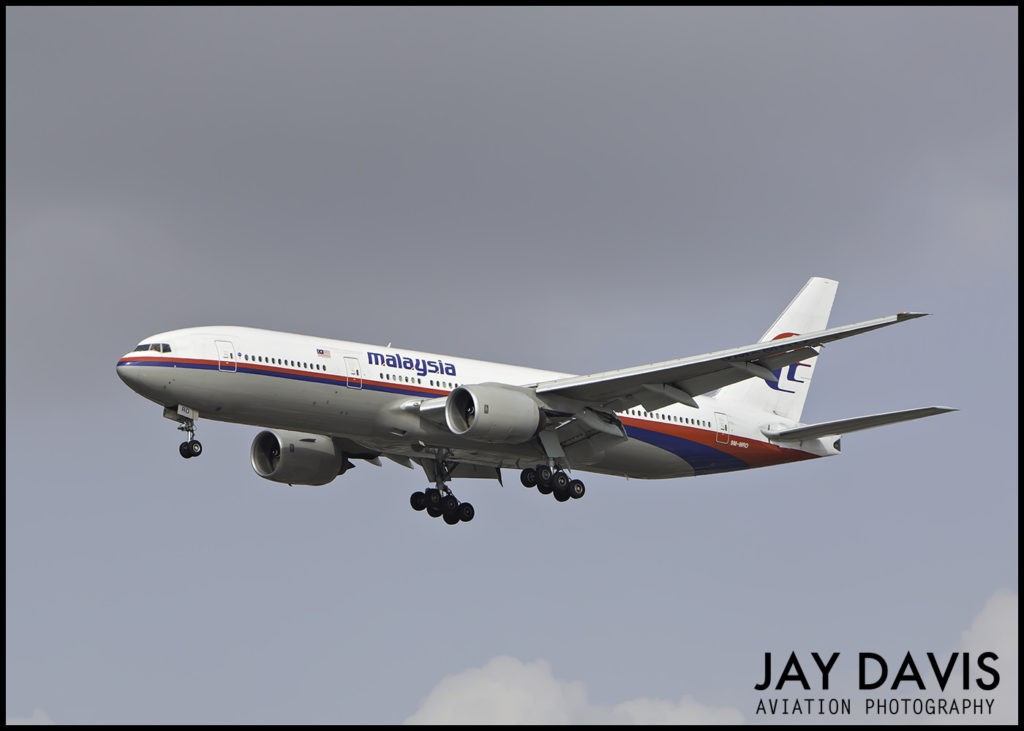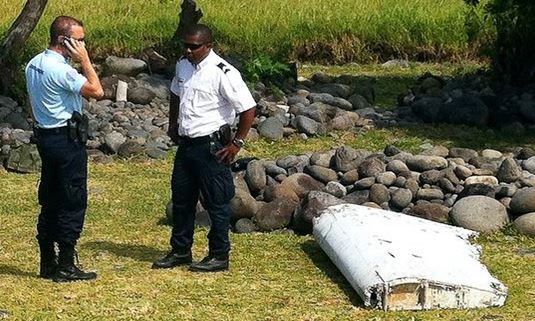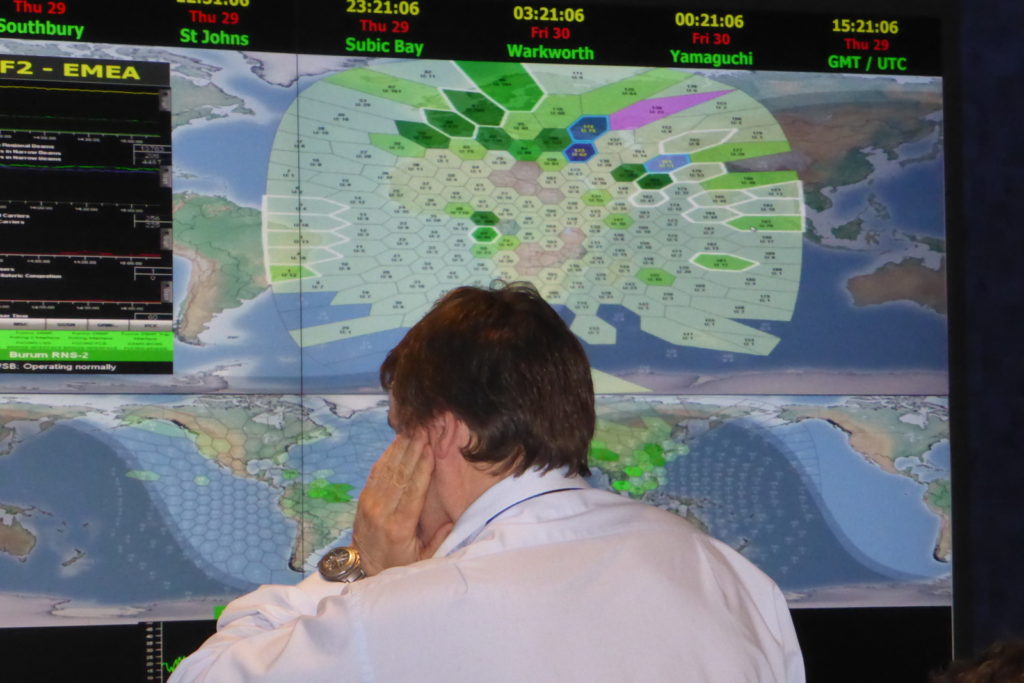
9M-MRO on approach to LAX photo courtesy Jay Davis
Australia’s news program 60 Minutes told viewers on Sunday that the only possible explanation for the disappearance of Malaysia 370 is “that a skilled pilot deliberately landed the 777 on the water.”
Headline-making to be sure, but it’s unlikely to have gone down the way the program suggests.
The twenty minute report by correspondent Ross Coulthart, rejuvenates the pilot suicide theory with the help of Larry Vance, who was a senior investigator for the Canadian Transport Safety Board during the crash of Swissair 111 in 1998.
The key to the MH370 mystery, according to Vance is in the flaperon, a flight control surface located at the back of the wing. Found on a beach in Reunion Island in 2015, it was the first piece of wreckage to wash up.

The flaperon on Reunion Island
In the pictures, the flaperon has a mangled edge which Vance finds significant. Only if the flaperon had been extended by the pilot by the time the plane hit the water would the edge be in that condition.
“The force of the water is the only thing that could make the jagged edge that we see,” Vance told the reporter.
“When the flaperon was found then everyone in my opinion should have concluded it was a human-engineered event,” Vance said, meaning that the pilot used it in an attempt to purposely land on the surface of the South Indian Ocean. “There’s no other explanation.”
Where this theory goes terribly wrong is in the inmarsat data.
All we know about where this plane flew after it veered from its path northeast to Beijing on the night of March 8, 2014, comes from the signals between the aircraft and the satellite. Analysis of those signals led searchers southwest, to the expansive ocean that has so far yielded very little.

An engineer at inmarsat’s office in London
But the inmarsat data also shows that more than seven hours after departing Kuala Lumpur International Airport, the airplane sent a very different kind of signal. This one, a handshake message, that indicated the airplane was powering back up from an interruption of some kind.
The interruption was probably caused by the two-engine, wide-body airliner finally running out of fuel and the power-up was the result of the deployment of a ram air turbine.
The turbine, called a RAT is like a big box fan without the box. The blade drops from beneath the airplane into the wind and the turning provides basic power to supply the most critical flight controls.
“The RAT powers tail and wing flight controls but not the flaps,” said Mike Bowers, a retired Boeing 777 captain. “There’s a one-way check valve to prevent RAT hydraulic fluid from getting to the flaps. So the RAT cannot power the flaps.”
Simply put, once the plane ran out of fuel, the pilots were unable to move the flaps or the flaperon if the RAT was the only power source. How the flaperon got its ragged edge, who knows, but we can be pretty sure, it wasn’t because the pilots were using it to perfect their water landing techniques.
In wholeheartedly embracing the guided-landing theory, Coulthart, the 60 Minutes reporter, overlooked a truly curious piece of news from the Australian Transport Safety Bureau that makes the ditching scenario even less likely.
“We’ve got a bit of hard data that says the aircraft was in a rapid rate of descent,” Peter Foley, a sea and marine engineer responsible for overseeing the ATSB’s search said.
Forgetting the issue of the RAT not powering the flap controls, this would put another damper on the pilot-controlled ditching theory because the flaperon can’t be deployed above 20 thousand feet or at speeds higher than 265 knots.
Foley told 60 Minutes, “We’ve got a rate of descent that’s between 12 to 20 thousand feet a minute.”
For those of you who need a little assistance with descent rate numbers, it’s like “going straight down,” another retired 777 pilot explained.
“Bottom line I don’t think you can recover from a 12 to 20 thousand foot rate of decent,” Bowers, a former military fighter pilot told me, if the suicide theory required the pilots to pull out of that kind of a dive, and then make a controlled ditching on the sea, it’s probably not possible he said. “I don’t think you can get an airplane stabilized without exceeding the structural integrity of the airplane.”
How the Australians have new data on the speed of the descent, is a mystery to me. There’s no radar, nor do I believe is this information available from the satellite.
It is possible that the rate of descent was extrapolated by an entity involved in the investigation. Boeing perhaps? Or maybe the French BEA, which has posession of the part. The engineers would only need to work backwards. How fast would the airplane have to be plummeting to cause the kind of damage seen on the flaperon? That’s my guess. Anyway, I’ve asked the ATSB for clarification.

Wreckage in the lab in Toulouse, France
But assuming the ATSB’s Foley wasn’t feeding nonsense to Australia’s “leading current affairs program”, the Boeing 777 pilots I talk to say an entirely different scenario can explain the speed and maybe even the damage on the flaperon.
After flying at cruise altitude seven and a half hours through the night, Malaysia 370 ran out of fuel. When the engines lost power, the RAT deployed. The plane may have wallowed a bit, one pilot told me, but but let’s get real, it could not fly forever. And this could explain the high speed descent.
With no discredit to the retired Canadian investigator Larry Vance, who I do not know but whom the reporter calls “one of the world’s best,” his guided-pilot theory is complex, unrealistic, in some aspects impossible.
What’s staring everyone in the face is a much more straightforward scenario involving no convoluted plots, or inexplicable mind games coming out of left field from a formerly well-regarded captain.
I don’t know for sure what happened to MH370, though you can read my theory in my soon-to-be-published book, The Crash Detectives. But it is equally perplexing how some scenarios ignore inconsistencies and disregard basic aviation principals to take viewers on a flight to the absurd.

Author of The New York Times bestseller, The Crash Detectives, I am also a journalist, public speaker and broadcaster specializing in aviation and travel.









Christine, thank you for this blog. I watched 60 Minutes (I would normally steer well clear of it). The narrow thinking, ignoring obvious holes in the theory, all in the name of sensationalism. It was a great demonstration of biased thinking in the name of trying to grab ratings.
I published this about MH370 on June 24, 2014:
“The unexamined FACT is that UK, USA, Russia, China, India, Israel, France, and whoever else ALL have satellites that are capable of reading the writing on a coin sitting on the ground …. It is absurd to hypothesize that after 5 plus hours, that not even ONE of these satellites was tracking MH-370. Pay attention: Somebody KNOWS!!”
S.S. McDonald
Captain Eastern Airlines (ret)
“ALL have satellites that are capable of reading the writing on a coin sitting on the ground”
At night time?
Think about field of view and your super duper space telescope that can read a coin from orbit… so the coin will need to be full screen on a monitor right?….. but think, now you’re trying to read the coin but all you know is that the coin was dropped somewhere in the snowy mountains national park. You have to FIND the coin in all that vastness first with your super telescope… and you can only see a few handspans of ground width at a time such is the great magnification.
Having such a degree of zoom actually makes finding something much harder if you don’t know exactly where it already is.
It might help to employ someone to review your spelling, It is Larry Vance, not Larry Vaughn.
Also, you are relying on one BFO data point and an assumption the airplane ran out of fuel and then restarted the satellite communications and was in a rapid descent. One of the main points in the 60 minutes piece was there were 2 million pieces of debris in similar crashes, if it truly were a high impact crash – but hardly anything in this one. Of course the source was a “retired Canadian”….
ps SS McDonald, satellites don’t capture images at night, the 7 hour flight was all at night until possibly the very end. Also Israel probably doesn’t have a satellite over the West Indian ocean looking for lost airplanes.
Christine, MH370’s rate of descent is calculated from BFO or Doppler shift of MH370’s signal transmission sent to the satellite, measured against a second pilot signal sent from Fucino, Italy. The difference in timing is measured in Hertz & gives a value for velocity rate of change.
Prior to 00:11 UTC there had been a steady progression:
@19:41 BFO= 111Hz
@20:41 BFO= 141Hz
@21:41 BFO= 168Hz
@22:41 BFO= 204Hz
@23:14 BFO= 216Hz
@00:11 BFO= 252Hz
In the 00:11 signal it became evident that MH370 was already slowing down by 0.315 knots/second which indicated the first engine had already flamed out.
Then at 00:19 UTC came a sudden dramatic change from the steady progression:
@00:19:29 BFO= 182Hz
@00:19:37 BFO= -2 Hz
Whilst there may be some quibbling over the rate of descent between experts the huge dramatic loss of altitude is not in doubt It was not a controlled glide by any length of imagination.
Flaps on a Boeing 777 use electrically powered rotary actuators. Once the RAT deployed MH370 could not lower flaps therefore the notion by Mr Vance that a pilot lowered the Flaperon to ditch the plane is nonsense.
In answer to the rate of descent the Boeing 777 is limited to 310kts IAS in an emergency descent, or 8,000 feet per minute.
To achieve this pilots may not lower the nose any greater than 10 degrees below the horizon and must use speed brakes to retard the speed all the way down, much like pulling the handbrake with a lever near the throttles.
Given both speed brakes & flaps need hydraulic pressure there was no way once engines were dead to maintain 310 KIAS, much less 180 VFE required for flap extension.
In a Boeing 777 the VMO is 330kts IAS above which is VNE speed where you would expect structural break up.
A final point is that the triangular NO STEP panel recovered by Blaine Gibson was torn away after suffering popped fasteners due to flutter. The metal honeycomb sandwich of that panel was brinnelled or pummeled & crushed in a manner caused by flutter art high speed.
Sorry Christine & others. Just to clear up confusion my first post may have caused. There are engine driven hydraulic pumps, supplemented by two electric driven pumps in the wheel wells. These provide torque through a gearbox in the wheel well to a geared shaft.
When the engines die the engine driven pumps obviously provide no pressure. APU can drive the electric driven pumps, but when the RAT deploys the whole system sheds electrical load so the electrical hydraulic pumps are not powered. Hope that clarifies?
Very good article. The title is perhaps a bit misleading as it appears to eliminate the whole pilot suicide theory based on one exaggerated and inaccurate TV documentary.
This was only aired on TV recent with its unique interpretation of the flaperon damage but the scenario of human involvement, with supporting evidence, has been around from the start in particular PM Najib’s “deliberately flown conclusion ” news conference on 14 March 2014.
Christine, you have this wrong on so many levels.
First the flaperon thing. We have an intact flaperon not a crashed flaperon. The difference is critical and it says we didn’t actually have a crash. Then reasoning backward, the aircraft didn’t run out of fuel (since it didn’t crash) meaning it was ditched as Larry Vance said. Also, where’s the debris? If we had a crash, where are the hundreds of seat cushions that “can be used for flotation” and all the other floating stuff? And BTW, Satcom is on main bus power so the rat wouldn’t power it up. Rather, the 777 has autostart on the APU so when the aircraft was flown into the water and the engines flamed out, the APU would start (powers all buses) causing the partial ping. Shortly after, it would flood and flame out. As for the high descent rate, I can tell you a transport aircraft at Vmo with speed brakes out comes down so fast it’s scary. Trust me. I’ve done it. Then we have the lack of a distress call at the initial turn off track point, the transponder and ACARS being off but Satcom working (read main bus power still on), and finally, and most damning, nearly the exact route flown up the Strait of Mallaca (published by Duncan Steel) found on Captain Shah’s home simulator!!!! If there was ever a clear case of malfeasance this is one. Can you actually believe a pilot partially incapacitated by hypoxia could turn off the transponder and ACARS, and then fly precisely up the Strait on a route that just coincidentally happened to be on the Captain’s simulator? That’s ridiculous. No Ms. Negronni, you’ve got this thing horribly wrong. John McClanahan, International Captain, 767ER, Atlanta
Well on this Capt. we are going to have to disagree.
Hey Christine, e-mail me. I’ll give you my number and we can chat. I promise it’ll be worth your time. Thanks – John McClanahan
Simon, where does the assumption the aircraft was out of gas and flamed out come from? What makes anyone think that? What Larry Vance said in the interview with Der Spiegel was that the aircraft was being flown by a pilot and intentionally ditched. It’s the only theory that explains all the facts. And no pilot would deliberately run out of gas before an intentional ditching. Therefore hydraulics and electrics would be fully operational and so would the flaps. And if you doubt the aircraft was being flown by our Captain Shah, check out the route found on his computer as published on Duncan Steel’s website. It almost precisely overlays the actual aircraft radar track. Just a coincidence? Can anyone actually believe that? No, Larry Vance is obviously right. As he said, “the only real mystery here is why someone would do this”.
An Open Letter to the Children of Capt. Zaharie Ahmad Shah Flight MH 370.Your father has been subject to much vexatious speculation since the disappearance of Flight MH730.
Most of this spurious rumor mill material does the originators little to no credit & should not be dignified by rational response.
Even at this stage many people owe you & your Dad an apology. They from their armchairs forget that anyone can do the job when all things are going right.
Aviation at all levels is played for keeps & is mightily unforgiving.
Capt Chris Goodfellow & the eye witness on the oil rig do him the most justice. One saw unknowing, the other knew unseen, that your father did his best to fly an aircraft that was intent on destroying itself.
To be alone in the air at night, in an aircraft that is suffering catastrophic failure, with the pressing responsibility for the lives of 100s of your passengers weighing down on you, is to be very much alone indeed.
Know that your father, faced with a very real & dire airborne emergency, did all in his power through his training, experience & courage to save Flight MH 370, without the luxury of time or options in his favour.
Like all senior pilots he would have never lost hope nor ceased every attempt to resolve a critical situation which eventually proved to be insurmountable.
From eye witness accounts & what we can reasonably surmise from the evidence thus far, your father reacted in the most professional, logical & decisive manner.
He displayed all the hall marks of good and quick judgment and decision making only gained from 18,000 hours in the left hand seat, and a cool, calm bravery that no peril can shake.
He may even have come very close to pulling off the impossible against all the odds stacked against him.
Know also that he would have commanded the total loyalty of his First Officer.
The emergencies you train for almost never happen. It’s the one you can’t train for that may test beyond the limit.
As the doyen of pilots Ernie Gann observed wryly fate is the hunter in these matters.
Capt. Zaharie Ahmad Shah would have commanded Ernie’s respect as he does from many at the pointy end of aviation.
Your father could have been anything he wanted to be. He chose aviation because he excelled at and loved flying.
He was a good & true man and a good father. You need hold nothing more than this love in your hearts for him for the rest of your lives.
He deserves nothing less than this from all of us.
With the greatest respect
Kindest condolences
Arthur Beau Palmer
Of course jaded pilots world weary with bureaucracy have been heard to comment
You might as well let the incident kill you, as the investigation surely will.
Hurst, R&L. Pilot Error The Human Factors. Jason Aronson Inc; 2nd edition (April 1983) ISBN-10: 0876686293
Aviation in itself is not inherently dangerous. But to an even greater degree than the sea, it is terribly unforgiving of any carelessness, incapacity or neglect ( by pilots & maintenance engineers & air traffic controllers).